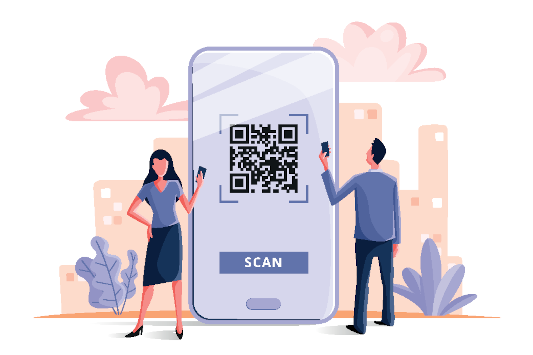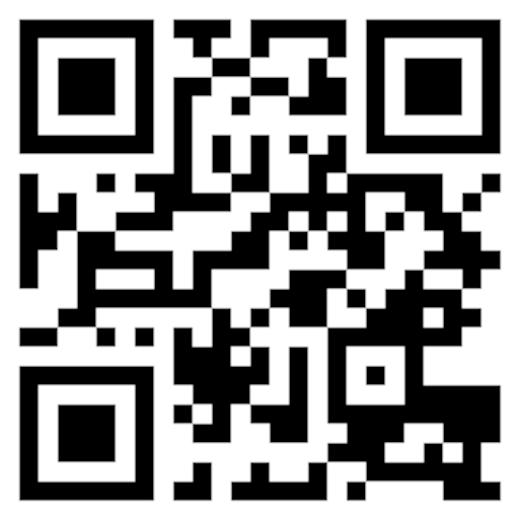Transform any text into a QR
How To
Type your desired text on the left.
Customize the QR Code appearance: color, size, logo, etc.
On the right, click to generate the QR Code.
Download or Scan the QR Code. Try It

What is a QR Code?
A Quick Response (QR) code is a type of two-dimensional matrix barcode that encodes data as a series of pixels in a square grid. It is designed for easy scanning by digital devices such as smartphones. The main purpose of QR codes is to store information that can be quickly and easily read by a camera.
This information can include web links, email addresses, pix QR codes, contact information, or other data types. QR codes are now widely used in various fields beyond their original use in automobile logistics.

QR Code provides the following features
High Capacity Encoding of Data
QR Code is capable of handling several dozen to several hundred times more information.
Small Printout Size
QR Code is capable of encoding the same amount of data in approximately one-tenth the space of a traditional barcode.
Kanji and Kana Capability
As a symbology developed in Japan, QR Code is capable of encoding JIS Level 1 and Level 2 kanji character sets.
Dirt and Damage Resistant
QR Code has error correction capability. Data can be restored even if the symbol is partially dirty or damaged.
Readable from any direction in 360
QR Code is capable of 360 degrees (omnidirectional), high-speed reading. QR Code accomplishes this task through position detection patterns located at the three corners of the symbol.
Structured Appending Feature
QR Codes can be divided into multiple data areas.
Types of QR Code
Short description of each one.
QR Code Model 1 and 2
Model 1 is the original QR Code, a code capable of coding 1,167 numerals.
Model 2 was created by improving Model 1, so that this code can be read smoothly if it is distorted in some way.
Micro QR code
Only one orientation pattern is required for this code,
making it possible to print it in a smaller space than before.
rMQR Code
Code addresses the need to print in narrow spaces
where conventional QR Codes could not be printed.
SQRC
That has a reading-restricting function.
It can be used to store private information.
Frame QR
IS a QR Code with a "canvas area" that can be flexibly used.
Since letters and images can be inserted inside the canvas area.

Best Practices
To produce one QR Code that brings conversion and engagement, we should follow some best practices
1- Determine the purpose of using one QR
Keep in mind some questions to make the decision:
- Why this barcode technology is the best choice?
- Will QR help you to achieve your marketing and business goals?
- Who is your target audience and how will they use the QR code?
- What action or information do you want your target audience to take away from the QR code?
Answering those questions, you are ready to create more effective QR Codes to reach and engage your audience and increase the user experience.
2- Grab user attention by personalizing each QR Code
With a little bit of creativity, you can turn your QR codes into eye-catching visual elements that will stand out from the crowd. You can achieve your goals, by adding colors, images, and brand logos.
3- Is the Qr Code scannable?
Yes, the mandatory requirement is making sure your QR code is scannable. Let me share with you some factors that must be considered to ensure that a camera device can read the QR Code:
- Physical Size: The minimum physical size of a visible QR code needs to be at least 2 cm by 2 cm (0.8 inches by 0.8 inches) (excluding quiet zone) for it to be readable and scanned successfully.
Real example: If the expected distance of the QR code from the QR code scanner is 20 inches, then the size of the QR Code should be at least 2 inches (height and width both). In other words: a QR code should have a 10:1 distance-to-size ratio.
The minimum digital QR code size for digital applications should be at least 240 pixels at 72 DPI - Contrast: One good contrast between foreground and background colors will be the key to a mobile phone camera better recognizing the QR Code. As a recommendation, you should use a light-coloured background (such as white or yellow) with a darker color for the foreground (such as black, brown, green, navy blue, etc).
- Sharpness and Clarity: Make sure that all the squares of the QR code are crisp and visible to the naked eye, in other words, independent of the QR code size, it should be sharp and clear enough, or a QR code scanner will not decode it. If you try to stretch, shrink, or skew your QR Code after it is generated could produce one completely unreadable.
- Design Quality: If you plan to add brand logos, images, or any other design elements, keep in mind and ensure they are high quality. Low resolution may reduce the QR code scannability.
- Print Resolution: If you need to print and display one physical QR code, the recommended resolution, in general, should be 300 dots per inch (DPI) resolution or higher.
- Framing and the “Quiet Zone”: First, you need to know what is one “Quiet Zone”. It refers to empty space or margin surrounding all four sides of the QR Code. Extra spaces help the scanner quickly identify and recognize the QR Code.
To increase the scannability success, confirm if the QR code is surrounded by a “Quite Zone” of roughly 15% of the whole QR Code dimension. Real example: If we have one QR code with 30 cm by 30 cm, then the quiet zone should be at least 4.5 cm on all four sides.
4- Utilise Error Correction Algorithms
QR Codes have an error correction capability, allowing them to recover data and remain the QR readable even if we have partial damage, dirty, or missing.
They offer four error correction levels, where the percentage reflects how much damage a barcode can take before becoming unreadable:
- Level L (Low): 7%
- Level M (Medium): 15%
- Level Q (Quartile): 25%
- Level H (High): 30%
Keep in mind that choosing a higher Error Correction level will reduce the maximum data storage capacity it increases the overall size of the QR Code.
5- Avoid Overcrowding your QR code
One simple advice is: to keep your QR Code simple and uncluttered. Use only a few design elements or text and minimize the visual noise around the QR Code.
6- Inverting the Colours of the Code is not recommended
Inverting colors (dark to light or vice versa) produces a negative effect on its scannability. It leads to an unsuccessful decoding process.
Note: The foreground color should always be darker than the background color.
7- Place QR codes at the right locations
- Place QRs on a Non-Contact Surface;
- Keep Comfort of Scanning in Mind;
- Let It Stand Out on the Collateral;
- Place the code where it receives minimum damage.
8- Include a CTA (Call-to-action)
Adding one clear call-to-action (CTA) with the QR Code is one key aspect to keep your customers engaged with your brand. CTAs are excellent for capturing people’s attention. Besides, some people may be hesitant to scan a QR Code if they do not know what is on the other hand.
Some examples of great CTAs are:
- Scan Me;
- Scan here to meet our team;
- Scan to download the app.
9- Mention the destination URL of the QR code
It brings Security: specifying the URL you ensure that visitors are aware of the content;
It acts as a Backup: If the QR gets damaged, users can manually enter the URL in their browser and access the content.
10- Avoid messing with the shape of the QR code
QR codes offer the flexibility to alter their shape. I do not recommend changing the shape of a QR code, because any modification can easily distort the pattern that makes up the code. Summarizing, It should reduce the scanning accuracy.
11- Ensure that your QR code leads to a mobile-optimized page
As many people use their devices to scan QR codes and access content behind them, make sure your content/page loads quickly, looks great on small devices, and is easy to navigate on a small screen.
12- Test the QRcode before you publish them
More Info
QR codes were developed in the 1990s to provide more information than a regular barcode. They were created by Denso Wave, a Toyota affiliate, to monitor the production of vehicles. In contrast to barcodes, which need a beam of light to bounce off the parallel lines, QR codes may be scanned digitally by devices like smartphones.
History of QR Code ...Create your own QR Code
Available QR Code generators (more is coming)